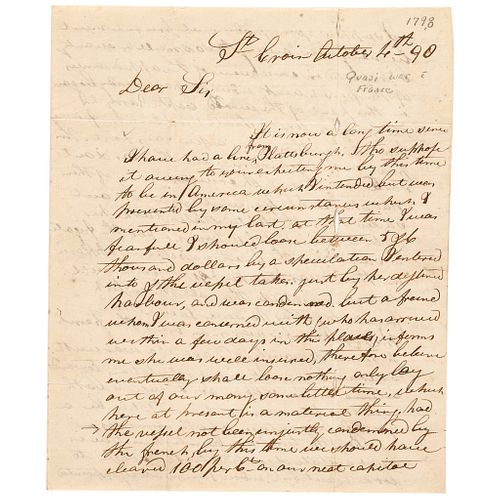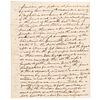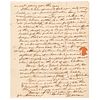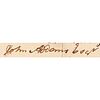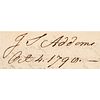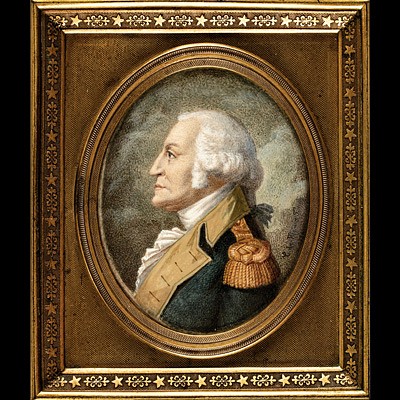1798 Quazi War Excellent Content Letter Capture of a French Privateer and More
Lot 130
Estimate:
$800 - $1,000
Absentee vs Live bid
Two ways to bid:
- Leave a max absentee bid and the platform will bid on your behalf up to your maximum bid during the live auction.
- Bid live during the auction and your bids will be submitted real-time to the auctioneer.
Bid Increments
| Price | Bid Increment |
|---|---|
| $0 | $10 |
| $200 | $20 |
| $300 | $25 |
| $500 | $50 |
| $1,000 | $100 |
| $2,000 | $200 |
| $3,000 | $250 |
| $5,000 | $500 |
| $10,000 | $1,000 |
| $20,000 | $2,000 |
| $30,000 | $2,500 |
| $50,000 | $5,000 |
| $100,000 | $10,000 |
| $200,000 | $20,000 |
| $300,000 | $25,000 |
| $500,000 | $50,000 |
About Auction
By Early American History Auctions
May 22, 2021
Set Reminder
2021-05-22 12:00:00
2021-05-22 12:00:00
America/New_York
Bidsquare
Bidsquare : Autographs-Colonial-Political-Americana
https://www.bidsquare.com/auctions/early-american-history-auctions/autographs-colonial-political-americana-6913
302 Lots of Rare, Historic Autographs, Americana, Civil War Era, George Washington, Abraham Lincoln, Slavery & Black History, Revolutionary War Era, Colonial America, Federal Period, War of 1812, Colonial Currency, Indian Peace Medals & more... Early American History Auctions auctions@earlyamerican.com
302 Lots of Rare, Historic Autographs, Americana, Civil War Era, George Washington, Abraham Lincoln, Slavery & Black History, Revolutionary War Era, Colonial America, Federal Period, War of 1812, Colonial Currency, Indian Peace Medals & more... Early American History Auctions auctions@earlyamerican.com
- Lot Description
Quasi-War
Excellent Content Letter Relating to the Capture of a French Privateer that "...out sailed all the English cruisers..."
October 4, 1798-Dated Post-Revolutionary War "Quasi-War" Period, Excellent Content Letter Relating to the Capture of a French Privateer that, "... out sailed all the English cruisers...", with Integral Transmittal Cover, Choice Very Fine.
October 4, 1798-Dated "Quasi-War" with France Period, beautifully written original Letter measuring 7.5" x 9" from J. S. Addoms to his father, Major John Addoms in Plattsburgh (NY) on Lake Champlain. This Letter is three written pages plus Integral Transmittal Cover. There is some minor wear holes on the outer fold lines, remnants of its red wax seal remain. Overall, boldly written in rich brown ink, easily readable on laid period paper, the letter is in nice condition but for the wear from transmittal. Contains good content with references to the "Quasi-War" with France that had just begun in July 1798, including a few lines regarding Captain John Barry's warship the frigate USS United States, which had Captured a French Privateer and that had outsailed all the English frigates in the area. It seems likely that the French Privateer is either the ship Sans Pareil or the Jalouse, both ships being Captured by John Barry around that period of time. Excellent historical content.
Major John Addoms (1737-1823) (also spelled Addams), joined the American cause at the outbreak of the American Revolution and rose to the rank of Major as a surveyor and civil engineer. He is said to have commanded the troops who laid the Iron Chain across the Hudson River at West Point to block the passage of British ships. Also, according to tradition, he held the hat of condemned British spy, Major John Andre' as he was led to the gallows for his part in Benedict Arnold's plot to betray West Point to the British in 1780
The Addoms (also spelled Addams) Collection offers both methods of giving insight into the realities of nineteenth century life in the North Country with records encompassing the years 1763-1872.
During this time three generations of one of Plattsburgh's earliest families conducted business, wrote to each other, about each other and put down in diaries, journals and school compositions their feelings and observations about their life and times. The result is a fascinating story of early American life.
The earliest records in the collection concern Major John Addoms (1737-1823). He originally came from Dutchess County, New York where he owned a large tract of land granted him by King George III prior to 1776.
He joined the American cause at the outbreak of the American Revolution and rose to the rank of Major as a surveyor and civil engineer. He is said to have commanded the troops who laid the Iron Chain across the Hudson River at West Point to block the passage of British ships. Also, according to tradition, he held the hat of condemned British spy, Major John Andre' as he was led to the gallows for his part in Benedict Arnold's plot to betray West Point to the British in 1780.
After his service in the revolution, John Addoms obtained land in Plattsburgh, settled his family there and was instrumental in attracting other settlers to the area. Addoms built a farm around 1790 on Cumberland Head with the help of slave labor and here he remained until his death. Today, the farm still stands and contains the family cemetery as well as a separate burial ground for the slaves.
His son, John Townsend Addoms (1781-1868) became a well known North Country Methodist Episcopal minister and a leader in the early temperance movement. His wife, Harriet Young Addoms of West Plattsburgh, was also involved in the temperance movement. They had eight children, five of whom died between the ages of thirteen and twenty. One died in infancy.
The majority of records (correspondence, diaries, journals, school compositions, etc.) in the collection are those of Reverend J. T. Addoms and his family between the years 1820-1872. They relate to family life, the development of the children, their schooling, interaction with friends and each other, and finally, the tragic period between February 25, 1839 and May 20, 1844, when five of them died. Included in the records are the poignant diary passages of a sister who watched two of her siblings pass away within three months of each other and additional entries where elegies were composed for them. Apparently, because of these deaths and because Reverend Addoms was constantly involved with deaths within his congregation, many of the miscellaneous materials in the collection concern death and dying in the form of poems and scrapbooks of obituaries, memorials, and religious literature.
Our Auction Contents:
Black History & Slavery: (Lots 1 - 63)
Abraham Lincoln Related: (Lots 64 - 74)
Historic Autographs: (Lots 75 - 235)
Colonial America: (Lots 236 - 261)
Revolutionary War: (Lots 262 - 304)
George Washington Related: (Lots 305 - 306)
Early American Guns & Weapons: (Lots 307 - 318) - Shipping Info
-
Early American provides in-house worldwide shipping. Please contact us directly if you have questions about your specific shipping requirements.
-
- Buyer's Premium



 EUR
EUR CAD
CAD AUD
AUD GBP
GBP MXN
MXN HKD
HKD CNY
CNY MYR
MYR SEK
SEK SGD
SGD CHF
CHF THB
THB